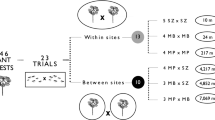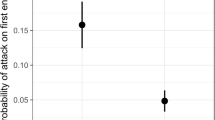Abstract
In studying the ant genus Azteca, a Neotropical group of arboreal species, we aimed to determine the extent to which the ants use predation and/or aggressiveness to protect their host plants from defoliating insects. We compared a territorially dominant, carton-nester, Azteca chartifex, and three plant-ant species. Azteca alfari and Azteca ovaticeps are associated with the myrmecophyte Cecropia (Cecropiaceae) and their colonies shelter in its hollow branches; whereas Azteca bequaerti is associated with Tococa guianensis (Melastomataceae) and its colonies shelter in leaf pouches situated at the base of the laminas. Whereas A. bequaerti workers react to the vibrations transmitted by the lamina when an alien insect lands on a leaf making it unnecessary for them to patrol their plant, the workers of the three other species rather discover prey by contact. The workers of all four species use a predatory behaviour involving spread-eagling alien insects after recruiting nestmates at short range, and, in some cases, at long range. Because A. alfari and A. ovaticeps discard part of the insects they kill, we deduced that the workers’ predatory behaviour and territorial aggressiveness combine in the biotic defence of their host tree.



Similar content being viewed by others
References
Agrawal AA, Dubin-Thaler BJ (1999) Induced responses to herbivory in the Neotropical ant-plant association between Azteca ants and Cecropia trees: response of ants to potential inducing cues. Behav Ecol Sociobiol 45:47–54
Benson WW (1985) Amazon ant-plants. In: Prance GT, Lovejoy TE (eds) Amazonia. Pergamon, Oxford, pp 239–266
Blum MS, Hermann HR (1978) Venom and venom apparatuses of the Formicidae: Dolichoderinae and Aneuretinae. In: Bettini S (ed) Arthropods Venoms. Springer-Verlag, Berlin Heidelberg New York, pp 871–894
Blüthgen N, Stork NE (2007) Ant mosaics in a tropical rainforest in Australia and elsewhere: A critical review. Aust Ecol 32:93–104
Clement LW, Köppen SCW, Brand WA, Heil M (2008) Strategies of a parasite of the ant–Acacia mutualism. Behav Ecol Sociobiol 62:953–962
Coley PD, Kursar TA (1996) Anti-herbivore defenses of young tropical leaves: physiological constraints and ecological trade-offs. In: Smith AP, Muclkey SS, Chazdon RL (eds) Tropical forest plant ecophysiology. Chapman and Hall, London, pp 305–336
Davidson DW (2005) Cecropia and its biotic defenses. Fl Neotrop Monog 94:214–226
Dejean A, Solano PJ, Ayroles J, Corbara B, Orivel J (2005) Arboreal ants build a trap to ambush and capture prey. Nature 434:973
Dejean A, Delabie JHC, Cerdan P, Gibernau M, Corbara B (2006) Are myrmecophytes always better protected against herbivores than other plants? Biol J Lin Soc 89:91–98
Dejean A, Corbara B, Orivel J, Leponce M (2007a) Rainforest canopy ants: the implications of territoriality and predatory behavior. Func Ecosyst Comm 1:105–120
Dejean A, Moreau CS, Uzac P, Le Breton J, Kenne M (2007b) The predatory behavior of Pheidole megacephala. C R Biologies 330:701–709
Dejean A, Djiéto-Lordon C, Orivel J (2008a) The plant-ant Tetraponera aethiops (Pseudomyrmecinae) protects its host myrmecophyte Barteria fistulosa (Passifloraceae) through aggressiveness and predation. Biol J Linn Soc 93:63–69
Dejean A, Grangier J, Leroy C, Orivel J, Gibernau M (2008b) Nest site selection and induced response in a dominant arboreal ant species. Naturwissenschaften 95:885–889
Delabie JHC (2001) Trophobiosis between Formicidae and Hemiptera (Sternorrhyncha and Auchenorrhyncha): an overview. Neotrop Entomol 30:01–516
Do Nascimento RR, Billen J, Sant’Ana AEG, Morgan ED, Harada AY (1998) Pygidial gland of Azteca NR. bicolor and Azteca chartifex: morphology and chemical identification of volatile components. J Chem Ecol 24:1629–1637
Farji Brener AG, Folgarait P, Protomastro J (1992) Asociatión entre el arbuso Capparis retusa (Capparidaceae) y las hormigas Camponotus blandus y Acromyrmex striatus (Hymenoptera: Formicidae). Rev Biol Trop 40:341–344
Gaume L, McKey D (1998) Protection against herbivores of the myrmecophyte Leonardoxa africana (Baill.) Aubrèv. T3 by its principal ant inhabitant Aphomomyrmex afer Emery. C R Acad Sc 321:593–601
Heil M, McKey D (2003) Protective ant-plant interactions as model systems in ecological and evolutionary research. Annu Rev Ecol Evol Syst 34:425–553
Hölldobler B, Wilson EO (1990) The ants. Springer-Verlag, Berlin Heidelberg New York
Janzen DH (1966) Coevolution of mutualism between ants and acacias in Central America. Evolution 20:249–275
Kenne M, Schatz B, Dejean A (2000) Hunting strategy of a generalist ant species proposed as a biological control agent against termites. Entomol Exp Appl 94:31–40
Kenne M, Mony R, Tindo M, Kamaha Njaleu LC, Orivel J, Dejean A (2005) The predatory behavior of a tramp ant species in its native range. C R Biologies 328:1025–1030
Longino JT (2007) A taxonomic review of the genus Azteca (Hymenoptera: Formicidae) in Costa Rica and a global revision of the aurita group. Zootaxa 1491:1–63
Mercier JL, Dejean A, Lenoir A (1998) Limited aggressiveness among African arboreal ants sharing the same territories: the result of a co-evolutionary process. Sociobiology 32:139–150
Rico-Gray V, Oliveira P (2007) The ecology and evolution of ant-plant interactions. The University of Chicago Press, Chicago, USA, 331pp
Sagers CL, Ginger SM, Evans RD (2000) Carbon and nitrogen isotopes trace nutrient exchange in an ant-plant mutualism. Oecologia 123:582–586
Styrsky JD, Eubanks MD (2007) Ecological consequences of interactions between ants and honeydew-producing insects. Proc R Soc Lond B 274:151–164
Trimble ST, Sagers CL (2004) Differential host use in two highly specialized ant-plant associations: evidence from stable isotopes. Oecologia 138:74–82
Vasconcelos HL, Casimiro AB (1997) Influence of Azteca alfari ants on the exploitation of Cecropia trees by a leaf-cutting ant. Biotropica 29:84–92
Wilson EO (1975) Enemy specification in the alarm-recruitment system of an ant. Science 190:798–800
Acknowledgements
We are grateful to Jacques H.C. Delabie, Roy R. Snelling and John T. Longino for the identification of different samples of our ants, and to Andrea Dejean for proofreading the manuscript. This work was supported by the Programme Amazonie II of the French Centre National de la Recherche Scientifique (project 2ID) and the Programme Convergence 2007–2013, Région Guyane from the European Community (project DEGA).
Author information
Authors and Affiliations
Corresponding author
Additional information
Communicated by J. Heinze.
Rights and permissions
About this article
Cite this article
Dejean, A., Grangier, J., Leroy, C. et al. Predation and aggressiveness in host plant protection: a generalization using ants from the genus Azteca . Naturwissenschaften 96, 57–63 (2009). https://doi.org/10.1007/s00114-008-0448-y
Received:
Revised:
Accepted:
Published:
Issue Date:
DOI: https://doi.org/10.1007/s00114-008-0448-y




